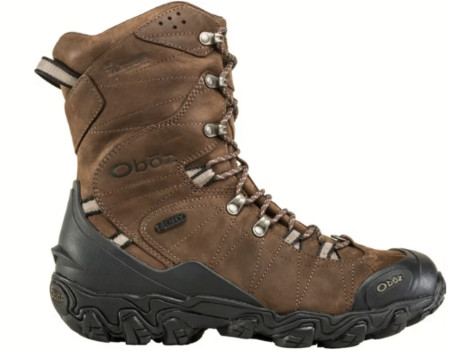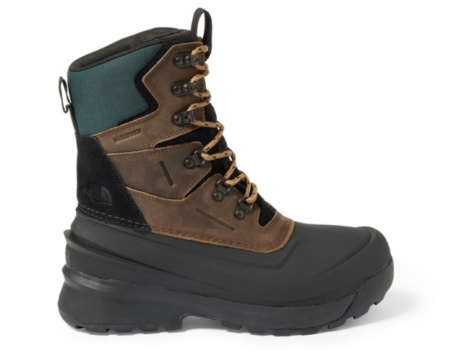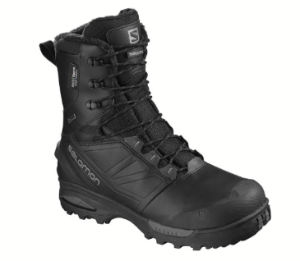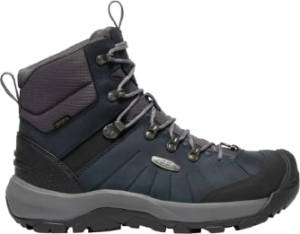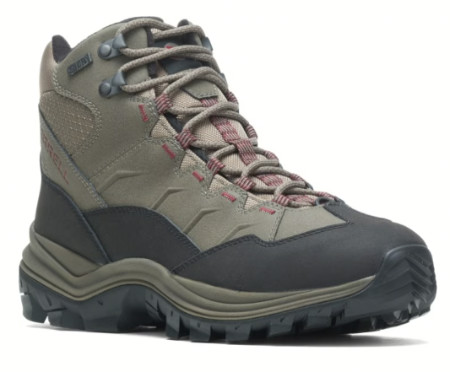Today’s winter hiking boots are waterproof, insulated, and compatible with traction aids such as microspikes, crampons, and snowshoes. While 200-gram Thinsulate insulated mids are fine for commuting and short local walks down to about 10-20 degrees (F), we recommend buying boots with higher calf coverage and 400-gram Thinsulate insulation for all-day hikes and mountain climbs in colder temperatures. We are experienced winter hikers with hundreds of successful mountain summits and understand what it takes to stay safe and comfortable on long and challenging winter hikes.
Here are our top 10 best winter hiking boot recommendations:
Best 400g Insulated Winter Hiking Boots
Most 400g insulated winter hiking boots are suitable for all-day winter hikes and snowshoeing excursions in temperatures in subzero temperatures. Most 400g boots have calf-high uppers which makes them warmer than mids because more of your lower leg is covered by insulation. While many manufacturers claim they’ll keep your feet warm down to -40F, that assumes that you’re actively hiking and not sitting around doing nothing. Realistically, they’re best worn in temperatures from 30F down to -15F. (If you plan to climb 4000-footers in winter in New Hampshire’s White Mountains, we recommend using 400g boots)
1. Oboz Bridger 10″ Insulated Winter Boots
2. KEEN Revel IV High Polar Winter Boots
3. The North Face Chilkat V 400
4. Salomon Toundra Pro
Please note: Salomon has had some production issues with these boots in recent years resulting in spilt seams. While our 2023 current pair has not demonstrated this issue, we still recommend purchasing them at REI so you can return them, even if used, should you experience a seam failure. We still believe they are excellent boots, but thought it best to tell you about this past issue.
Best 200g Insulated Winter Hiking Boots
Most 200g winter hiking boots are ankle-high mids and retain less lower leg heat than calf-height 400g boots. On the flip side, they’re a little easier to hike with because they’re lighter weight and feel more like regular hiking boots. 200g boots are best worn in temperatures from 30F down to 10F and are best used in milder winter conditions and shorter duration hikes where there’s less chance you’ll be caught out after dark when temperatures fall.
5. Oboz Bridger 8″ Insulated Winter Mids
6. KEEN Revel IV Mid Polar Winter Boots
7. Columbia Bugaboot III Insulated Winter Boots
8. Merrell Thermo Chill Mid WP Boots
Best Mountaineering Boots for Winter Hiking
Mountaineering boots have rigid soles that make them compatible with crampons that lack flexible center bars, for use on rugged mountains with higher slope angles or thick ice. While you can hike in them, it’s a very different feeling than a soft-soled 400g or 200g insulated winter hiking boot. While insulated, most mountaineering boot manufacturers do not rate their boots’ temperature ranges, so you need to rely on anecdotal word-of-mouth assessments of their warmth level. If you hike across glaciers or on trips led by mountaineering guides, it’s usually best to ask them for their advice on what boots to bring. They may even rent you boots to use.
9. La Sportiva Nepal EVO GTX Mountaineering Boots
10. Scarpa Ribelle HD Mountaineering Boots
How to Select Winter Hiking Boots
Winter boots should be waterproof and insulated to keep your feet dry and warm, they should have laces, they should be comfortable so you can wear them all day, and they should be compatible with traction aids like microspikes and snowshoes. While the amount of insulation you need will vary, winter boots with non-removable synthetic insulation are the lightest weight and therefore the easiest to hike in. Boots made with synthetic materials are also lighter weight and more waterproof than leather boots.
The reason you can’t use your regular 3 season boots or shoes for winter hiking, comes down to waterproofing and insulation. Most insulated winter hiking boots are guaranteed waterproof out of the box. Many have lowers made with rubber or waterproof synthetics so you don’t have to worry about the fabric absorbing water. If you do get moisture in your boots, insulated winter boots will still keep them warm. The same can’t be said about leather hiking boots, even when treated with waterproofing creams and sprays. If your regular hiking boots absorb water in winter, they can freeze and lead to frostbite.
Some boot manufacturers provide temperature ratings for their products, but there’s no standard way for measuring the warmth of winter boots. Understand that these ratings are estimates at best and that users will have varying experiences based on their activity level, health, weight, sex, metabolism, and other factors.
Some winter boot manufacturers publish the thickness of the insulation in their boots, while others don’t. For example, some boots have 200 gram Thinsulate insulation, a popular synthetic insulation, while others use 400-gram insulation.
- Four of the boots listed above have 400-gram insulation or the equivalent, so they can be used well below zero. This is the insulation we recommend if you hike in the backcountry, where winter hikes may last far longer than anticipated.
- Four more have 200-gram insulation which is suitable for hiking in temperatures down to 20-30F, especially in later fall or early spring when there isn’t that much snow on the ground.
- The other two pairs of boots are intended for light-to-mid mountaineering, but can also be used for more serious winter hiking.
Key Winter Boot Features
Temperature ratings
While you need to take the manufacturer’s temperature ratings with a grain of salt, they are a good indication of the relative warmth of a boot. While it’s difficult to make warmth comparisons between boots that have different kinds of insulation, knowing the amount of insulation used in boots can help you compare the warmth of different models made by the same manufacturer.
Gusseted tongue
This is just like a regular boot tongue, except the sides are closed and sewn to the side of the boots to prevent water from leaking into the boot when you step in puddles.
Reinforced toe cap
In addition to providing more protection, a beefy toe cap won’t collapse the front of the boot when worn with microspikes or crampons.
Lugs
The soles of your boots should provide good traction when walking on loose or packed snow. Look for boots with a deep tread like a Vibram sole, although you’re likely to augment your boot with microspikes.
Cuff
Looks for boots with a soft cuff that closes off the gap between your leg and boot.
Gaiter ring
A gaiter ring is a small ring attached to the top of the boot that you can hook your gaiters onto. It’s not the end of the world if your boots don’t have one since can still hook the gaiter to your boot laces.
See Also:
Check Out All of SectionHiker’s Winter Gear Guides!
SectionHiker is reader-supported. We only make money if you purchase a product through our affiliate links. Help us continue to test and write unsponsored and independent gear reviews, beginner FAQs, and free hiking guides.

